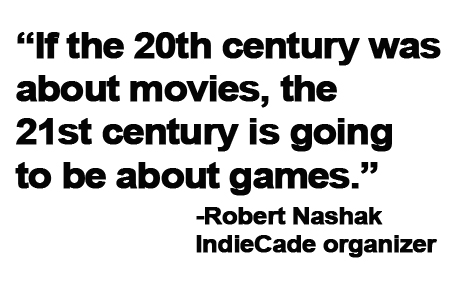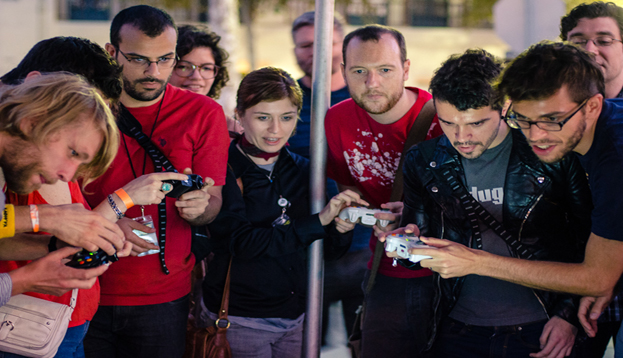Editor’s note: IndieCade organizers are offering discounted passes for [a]list daily readers – see details at the end of the article.
Video games are getting their annual Hollywood close-up this weekend as IndieCade descends on Los Angeles for the fifth year in a row. The event started in 2008 as a showing of about two dozen independently developed games at an art gallery in Bellevue, Washington. Since relocating to the epicenter of entertainment, its aspirations have grown. It’s now attracting big game companies, with Sony, Microsoft, Nintendo and Activision standing behind this year’s show. And while the focus with most exhibits is on future talent and unknown games, the show’s highlights are studded with presentations by seasoned game makers and high-end game tech on display.

According to one of IndieCade’s founding members, the event is now embracing its role in raising awareness that games are not only a dominant cultural force but the future of entertainment, and doing it under the shadow of film and TV companies.
“What we have here with IndieCade is the clarion call — trumpets blaring — that this century that we’re living in right now is going to be about games,” said Robert Nashak, one of the original organizers of the event. “If the 20th century was about movies, the 21st century is going to be about games.”
IndieCade was founded by Stephanie Barish, a digital media academic who recognized an opportunity to create a showcase for startup developers just as digital distribution began broadening the market for smaller games. The first event took shape in 2008 with the gallery showing in Bellevue. It made the jump to the Los Angeles area the next year after Barish had a chance encounter with the mayor of Culver City, a Westside L.A. community well-known for its cluster of TV and film production companies. That proximity to the traditional entertainment industry gave the show a newfound identity, something the Los Angeles Times helped define when it welcome its regional debut with the headline, “IndieCade, the video game industry’s Sundance.”
Nashak said that’s exactly what IndieCade is now aspiring to be. But unlike Sundance, which represented independent filmmakers wanting to get out of the L.A. film industry fishbowl, IndieCade wants to make a splash right in the middle of it.
“The spirit of it is like Sundance,” he said, adding, “We’re locating ourselves here because one, L.A. is the center of the TV and film industry, we know that. But two, it’s also the center of, on so many different levels, the commercial games industry. This is where E3 happens, this is where Activision-Blizzard is, one of the largest publishers in the world right now, and it’s also where Riot Games is, [makers of] one of the most of, if not the most, popular online games right now.”
Nashak, whose background bridges games and traditional entertainment, pointed out that he’s taking an active role in taking IndieCade to the next level. The show has expanded to exhibits at major game industry trade shows E3 and GDC, and has organized offshoots such as IndieCade East {link no longer active}. With this upcoming main event, which spans across theaters and different venues in Culver City, the show has grown to more than 100 exhibitors, and it’s anticipating thousands of attendees.
“As an organization, our goal is to really, really drill down and figure out what can we do to help game developers get out there, get known, get discovered. What can we do to get the word that many games are about artistry,” Nashak said.
Yet IndieCade’s newfound goal to elevate games in the eyes of major entertainment companies is also coming through. The presence of big game makers is undeniable this year. And based on press coverage and the conversation with Nashak, one of the areas of game development taking center stage this weekend is projects aimed at the Oculus Rift virtual reality headset. The headset has captured a lot of attention in the game industry and is badly in need of innovative new content, but developing for it isn’t exactly the kind of undertaking you’d expect from tiny indies and garage groups.
“We had this moment in the ’90s when VR was all the rage and everyone was talking about virtual reality, and now it’s come back to the fore thanks in large part to Oculus Rift and all of the buzz that’s generated,” said Nashak. “What you’re going to see at IndieCade, which we’re really excited about, is companies that have built up startups around the Oculus to really bring that technology to the next level.”
One example is Project Holodeck, a L.A.-based company that has developed full-body motion sensors and game controllers that deepen the Oculus Rift experience into nearly total immersion. It’s the kind of technology and experience-facilitator that should excite anyone who considers themselves creators of story worlds, whether they’re creating those worlds for film, TV or games.
Nashak teaches a course on business management and entrepreneurialism in games at the USC Film School’s Interactive Media and Games Division. He says that crossover mentality is part of what he’s trying to pass on to this coming generation of entertainment creators.
“The people interested in film and TV only think about film and TV, and the people interested in games just think about games,” he said. “What I’m trying to get people to think about is, how do you think holistically about entertainment media. Thinking about cross-platform story world development from the get-go – I think that’s what we’re trying to get people to understand.”

